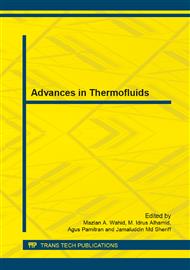[1]
A.E. Bergles, Some perspectives on enhanced heat transfer, second-generation heat transfer technology, J. Heat Transf. 110 (2000) 1082.
DOI: 10.1115/1.3250612
Google Scholar
[2]
R.L. Webb, N.H. Kim, Principles of Enhanced Heat Transfer, second ed. Taylor &Francis Group, New York, NY, (2006).
Google Scholar
[3]
D. Westphalen, K. Roth, J. Brodrick, Heat transfer enhancement, ASHRAE J. 48 (2006) 68e71.
Google Scholar
[4]
B. Sunden, G. Xie, Gas turbine blade tip heat transfer and cooling: a literature survey, Heat Transf. Eng. 31 (2010) 527e554.
DOI: 10.1080/01457630903425320
Google Scholar
[5]
R. Kamali , A.R. Binesh, The importance of rib shape effects on the local heat transfer and flow friction characteristics of square ducts with ribbed internal surfaces, International Communications in Heat and Mass Transfer, vol. 35 (2008).
DOI: 10.1016/j.icheatmasstransfer.2008.04.012
Google Scholar
[6]
A. Korichi, L. Oufer, Numerical heat transfer in a rectangular channel with mounted obstacles on upper and lower walls, International Journal of Thermal Sciences, vol. 44 (2005) pp.644-655.
DOI: 10.1016/j.ijthermalsci.2004.12.003
Google Scholar
[7]
A. Korichi, L. Oufer, Heat transfer enhancement in oscillatory flow in channel with periodically upper and lower walls mounted obstacles, International Journal of Heat and Fluid Flow, vol. 28 (2007) pp.1003-1012.
DOI: 10.1016/j.ijheatfluidflow.2006.11.002
Google Scholar
[8]
S. Eiamsa-ard, P. Promvonge, Numerical study on heat transfer of turbulent channel flow over periodic grooves, International Communications in Heat and Mass Transfer, vol. 35 (2008) pp.844-852.
DOI: 10.1016/j.icheatmasstransfer.2008.03.008
Google Scholar
[9]
C.O. Olsson, B. Sundén, Experimental study of flow and heat transfer in rib-roughened rectangular channels, Experimental Thermal and Fluid Science, vol. 16 (1998) pp.349-365.
DOI: 10.1016/s0894-1777(97)10034-6
Google Scholar
[10]
X. Gao, B. Sunden, Heat transfer and pressure drop measurements in rib-roughened rectangular ducts, Experimental Thermal and Fluid Science, vol. 24 (2001) pp.24-33.
DOI: 10.1016/s0894-1777(00)00054-6
Google Scholar
[11]
S D.H. Lee, D.H. Rhee, K.M. Kim, H.H. Cho, H.K. Moon, Detailed measurement of heat/mass transfer with continuous and multiple V-shaped ribs in rectangular channel, Energy, vol. 34 (2009) pp.1770-1778.
DOI: 10.1016/j.energy.2009.07.011
Google Scholar
[12]
A. Chaube, P.K. Sahoo, S.C. Solanki, Analysis of heat transfer augmentation and flow characteristics due to rib roughness over absorber plate of a solar air heaterRenewable Energy 31 (2006) 317–331.
DOI: 10.1016/j.renene.2005.01.012
Google Scholar
[13]
F.P. Incropera, D.P. De Witt, Fundamentals of Heat and Mass Transfer. New York: John Wiley and Sons, (2002).
Google Scholar
[14]
W. Changcharoen, S. Eiamsa-ard, Numerical investigation of turbulent heat transfer in channels with detached rib-arrays, Heat Transfer - Asian Research, vol. 40 (2011) pp.431-447.
DOI: 10.1002/htj.20357
Google Scholar
[15]
Saqr, K.M., H.S. Aly, H.I. Kassem, M.M. Sies, and Mazlan A. Wahid, Computations of Shear Driven Vortex Flow in a Cylindrical Cavity Using a Modified k-e Turbulence Model. International Communications in Heat and Mass Transfer, 2010. 37(8): pp.1072-1077.
DOI: 10.1016/j.icheatmasstransfer.2010.06.021
Google Scholar
[16]
Saqr, K.M., H.S. Aly, and Mazlan A. Wahid, and M.M. Sies, Numerical Simulation of Confined Vortex Flow Using a Modified k-epsilon Turbulence Model. CFD Letters, 2009. 1(2): pp.87-94.
Google Scholar
[17]
Saqr, K.M., H.S. Aly, M.M. Sies, and Mazlan A. Wahid, Computational and Experimental Investigations of Turbulent Asymmetric Vortex Flames. International Communications in Heat and Mass Transfer, 38 (2011) 353 – 362.
DOI: 10.1016/j.icheatmasstransfer.2010.12.001
Google Scholar


